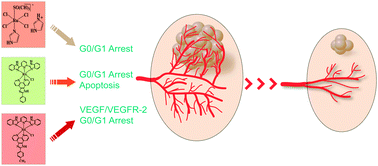Antiangiogenic ruthenium(ii) benzimidazole complexes, structure-based activation of distinct signaling pathways†
Abstract
Antiangiogenic therapy is considered to be a promising strategy for the treatment of cancers. VEGF and its receptors are important angiogenic factors involved in tumor growth. In the present study, the new ruthenium(II) complexes containing 2,6-bis(benzimidazolyl)pyridine have been identified as potent antiangiogenic agents in vitro and in vivo, through activation of distinct antiangiogenic signaling pathways. Specifically, [Ru(bbp)(p-mpip)Cl]ClO4 (complex 2, bbp = 2,6-bis(benzimidazolyl)pyridine; p-mpip = 2-(4-methylphenyl)imidazo[4,5-f]-1,10-phenanthroline) exhibited the highest antiangiogenic activity, as evidenced by significant suppression of neovessel formation in chick chorioallantoic membranes and blockage of the angiogenesis in a matrigel plugs assay, which are significantly higher than those of the most accepted anti-metastasis ruthenium-based drug NAMI-A. Generally, these kinds of complexes induced the G0/G1cell cycle by inhibiting the formation of a Cyclin D1/CDK4 complex and CDK2 activation, through up regulation of the expression levels of p15INK4B, p21Cip1 and p27Kip1. Moreover, the complexes also triggered intracellular DNA damage, and thus activated the phosphorylation of ATM, ATR, CHK1, Histone and p53. The suppression of Akt and ERK1/2 pathways reinforced the cell cycle perturbation effects of the complexes. Interestingly, complex 2 displayed strong inhibition on the activation of VEGF and VEGFR-2 phosphorylation, which blocked the transmission of the mitogenic signal through Akt and ERK1/2 pathways, and thus enhanced cell cycle arrest. In contrast, we found that the most accepted anti-metastasis ruthenium based drug NAMI-A exerted lower antiangiogenic activity via activation of the DNA damage-mediated pathway, but showed no effects on VEGF and VEGFR-2 phosphorylation. Taken together, this study clearly demonstrates the distinct antiangiogenic mechanisms of metal complexes, and these kinds of complexes can be further developed as anti-vascularized drugs and as alternative agents of NAMI-A for the treatment of cancers.


 Please wait while we load your content...
Please wait while we load your content...